Max Brückner, From His Book Vielecke Und Vielfläche, 1900. Leipzig, Germany. Via Bulatov.
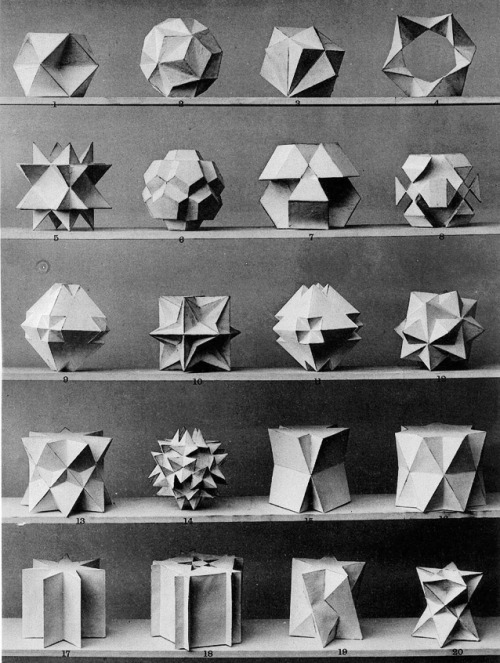
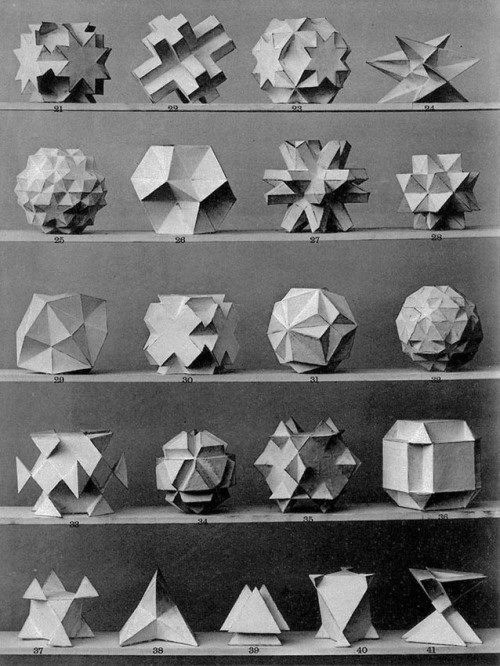
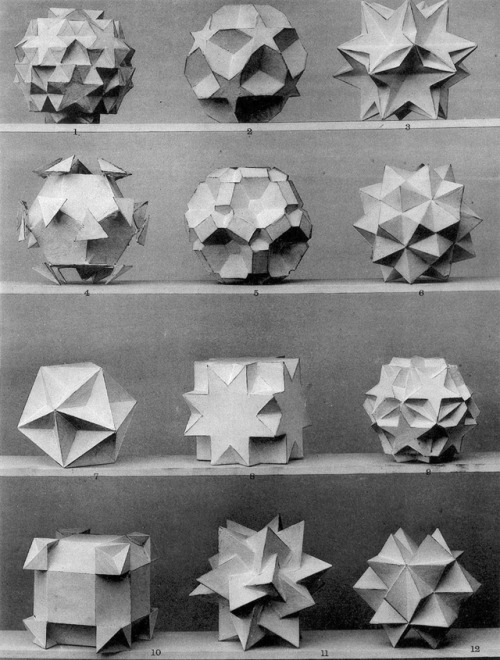
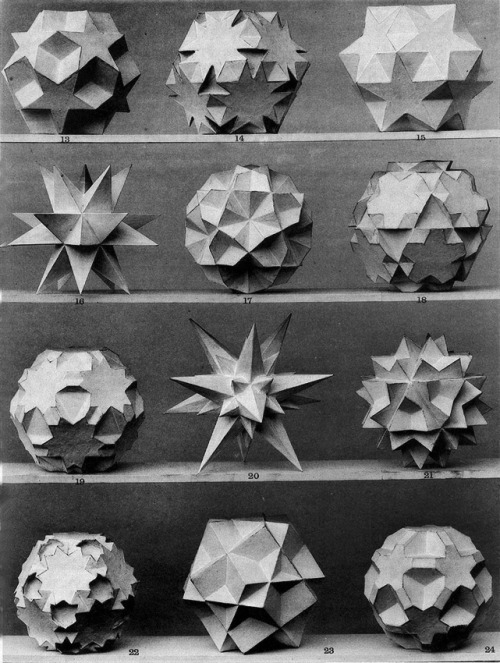
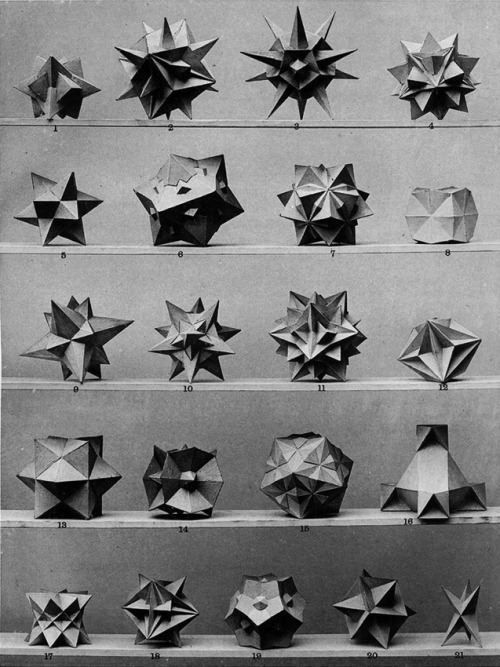




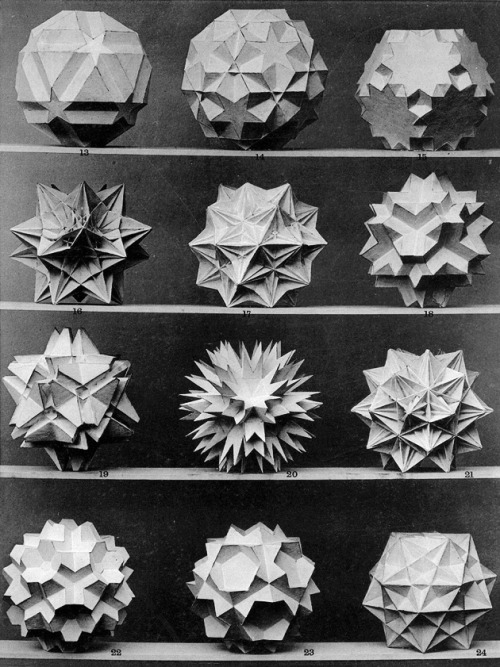
Max Brückner, from his book Vielecke und Vielfläche, 1900. Leipzig, Germany. Via Bulatov.
Brückner extended the stellation theory beyond regular forms, and identified ten stellations of the icosahedron, including the complete stellation. wiki
More Posts from Hannahhaifisch and Others


A photo of Saturn. Took by Hubble with HSTWFPC2 on December 09, 2002 at 10:36:16. Detail page on OPUS database.

A new study publishing this week in the Astrophysical Journal by Gary Prézeau of NASA’s Jet Propulsion Laboratory, Pasadena, California, proposes the existence of long filaments of dark matter, or “hairs.” http://ift.tt/1NdQIKk

“XYZ I” by ale_beber_origami http://flic.kr/p/TiaETp

Researchers discover that chaos makes carbon materials lighter and stronger
In the quest for more efficient vehicles, engineers are using harder and lower-density carbon materials, such as carbon fibers, which can be manufactured sustainably by “baking” naturally occurring soft hydrocarbons in the absence of oxygen. However, the optimal “baking” temperature for these hardened, charcoal-like carbon materials remained a mystery since the 1950s when British scientist Rosalind Franklin, who is perhaps better known for providing critical evidence of DNA’s double helix structure, discovered how the carbon atoms in sugar, coal, and similar hydrocarbons, react to temperatures approaching 3,000 degrees Celsius (5,432 degrees Fahrenheit) in oxygen-free processing. Confusion over whether disorder makes these graphite-like materials stronger, or weaker, prevented identifying the ideal “baking” temperature for more than 40 years.
Fewer, more chaotically arranged carbon atoms produce higher-strength materials, MIT researchers report in the journal Carbon. They find a tangible link between the random ordering of carbon atoms within a phenol-formaldehyde resin, which was “baked” at high temperatures, and the strength and density of the resulting graphite-like carbon material. Phenol-formaldehyde resin is a hydrocarbon commonly known as “SU-8” in the electronics industry. Additionally, by comparing the performance of the “baked” carbon material, the MIT researchers identified a “sweet spot” manufacturing temperature: 1,000 C (1,832 F).
Read more.


Galena and Fluorite - Blackdene Mine, Ireshopeburn, Weardale, Co. Durham, England





Fluorite and Baryte
Locality: Berbes, Asturias, Spain


Agate
Locality: Rio Grande do Sul, Brazil


Moss Green Halite
Locality: Sieroszowice Mine, Lower Silesia, Poland








Hubble Views The Final Frontier For Dark Matter
“This phenomenon of gravitational lensing stretches galaxies into streaks and arcs, magnifying them, and creating multiple images. It also enables us to reconstruct the mass distribution of the cluster, revealing that it’s mostly due to dark matter.”
When you look out at the distant Universe, you can see all sorts of things: stars, galaxies, clusters of galaxies, going as far back into the distant past as our telescopes can image. But where you have the greatest concentrations of mass, an extreme phenomenon emerges: that of gravitational lensing. Any foreground objects lying behind that mass will have their light stretched, magnified and distorted by the intervening matter. Recently, as part of the Hubble Frontier Fields program, the telescope followed-up on galaxy cluster Abell 370, and revealed the most spectacular gravitational lensing signal ever seen in a galaxy cluster. Most importantly, it provides some very strong evidence not only for dark matter’s existence, but for its presence distinct from any galaxies at all.
Come get the full story in images, videos, and no more than 200 words on this edition of Mostly Mute Monday!
-
 juliantxu64 liked this · 2 weeks ago
juliantxu64 liked this · 2 weeks ago -
 saucerkommand liked this · 3 weeks ago
saucerkommand liked this · 3 weeks ago -
 tiger-feather reblogged this · 3 weeks ago
tiger-feather reblogged this · 3 weeks ago -
 prickalee reblogged this · 3 weeks ago
prickalee reblogged this · 3 weeks ago -
 hollowjack92 liked this · 4 weeks ago
hollowjack92 liked this · 4 weeks ago -
 gofancycollectionflowers-blog liked this · 4 weeks ago
gofancycollectionflowers-blog liked this · 4 weeks ago -
 dbelskyi liked this · 4 weeks ago
dbelskyi liked this · 4 weeks ago -
 scentwitchtheorist liked this · 3 months ago
scentwitchtheorist liked this · 3 months ago -
 nothinglastsforever8 liked this · 5 months ago
nothinglastsforever8 liked this · 5 months ago -
 myadrenalinepearls reblogged this · 7 months ago
myadrenalinepearls reblogged this · 7 months ago -
 christopherhornadayphotography liked this · 10 months ago
christopherhornadayphotography liked this · 10 months ago -
 androidsghost liked this · 11 months ago
androidsghost liked this · 11 months ago -
 thdutkdtu reblogged this · 1 year ago
thdutkdtu reblogged this · 1 year ago -
 qpalzmskwii reblogged this · 1 year ago
qpalzmskwii reblogged this · 1 year ago -
 andlastlyimustsay reblogged this · 1 year ago
andlastlyimustsay reblogged this · 1 year ago -
 sid766 liked this · 1 year ago
sid766 liked this · 1 year ago -
 onedayvacation liked this · 2 years ago
onedayvacation liked this · 2 years ago -
 petrusnemo liked this · 2 years ago
petrusnemo liked this · 2 years ago -
 ofhiddenthings liked this · 2 years ago
ofhiddenthings liked this · 2 years ago -
 alanshemper reblogged this · 2 years ago
alanshemper reblogged this · 2 years ago -
 been-here-since-76 liked this · 2 years ago
been-here-since-76 liked this · 2 years ago -
 prjulioca reblogged this · 2 years ago
prjulioca reblogged this · 2 years ago -
 spaceman70 reblogged this · 2 years ago
spaceman70 reblogged this · 2 years ago -
 spaceman70 liked this · 2 years ago
spaceman70 liked this · 2 years ago -
 picknickbasket reblogged this · 2 years ago
picknickbasket reblogged this · 2 years ago -
 maremao liked this · 2 years ago
maremao liked this · 2 years ago -
 nlogtaem reblogged this · 2 years ago
nlogtaem reblogged this · 2 years ago -
 marciofortuna liked this · 2 years ago
marciofortuna liked this · 2 years ago -
 for1010101010 liked this · 3 years ago
for1010101010 liked this · 3 years ago -
 concupiscience reblogged this · 3 years ago
concupiscience reblogged this · 3 years ago -
 midrashic liked this · 3 years ago
midrashic liked this · 3 years ago -
 sp1ne-sh0t liked this · 3 years ago
sp1ne-sh0t liked this · 3 years ago -
 banachtarskiparadox reblogged this · 3 years ago
banachtarskiparadox reblogged this · 3 years ago -
 banachtarskiparadox liked this · 3 years ago
banachtarskiparadox liked this · 3 years ago -
 the-gayest-dovah reblogged this · 3 years ago
the-gayest-dovah reblogged this · 3 years ago -
 the-gayest-dovah liked this · 3 years ago
the-gayest-dovah liked this · 3 years ago -
 isaactheastronaut reblogged this · 3 years ago
isaactheastronaut reblogged this · 3 years ago -
 arbormortis liked this · 3 years ago
arbormortis liked this · 3 years ago -
 kobithedragon liked this · 3 years ago
kobithedragon liked this · 3 years ago -
 isaactheastronaut reblogged this · 3 years ago
isaactheastronaut reblogged this · 3 years ago -
 bingo25 reblogged this · 3 years ago
bingo25 reblogged this · 3 years ago